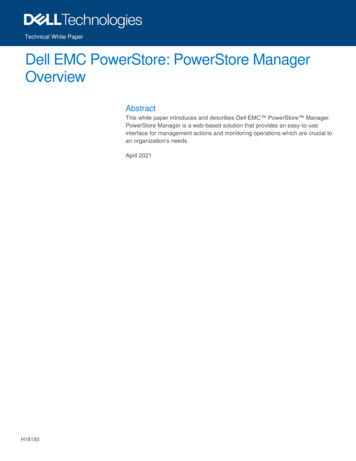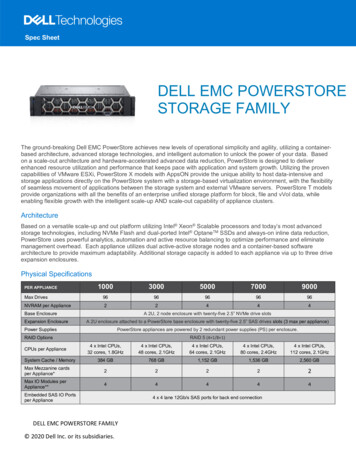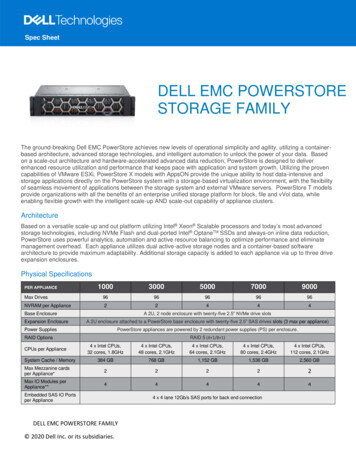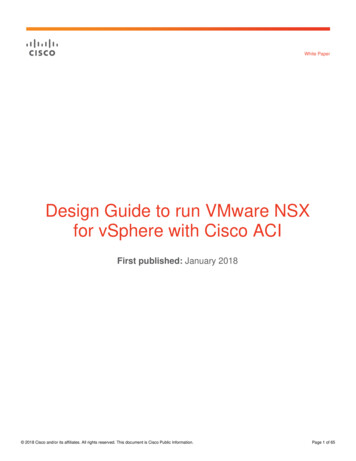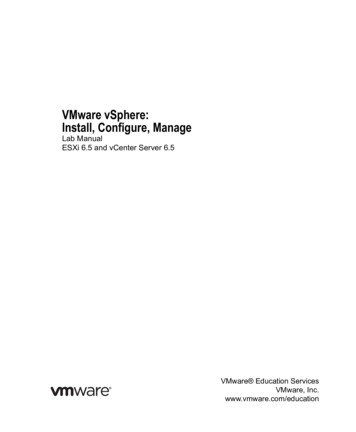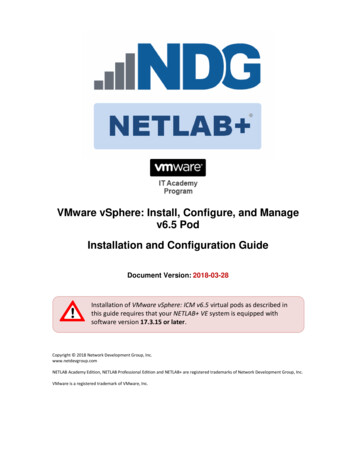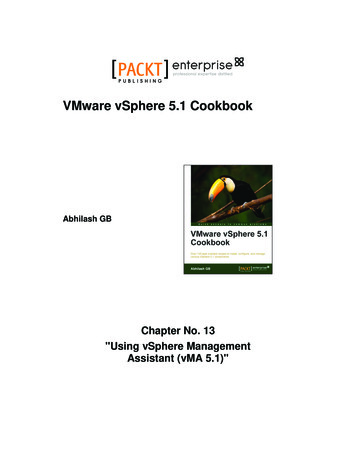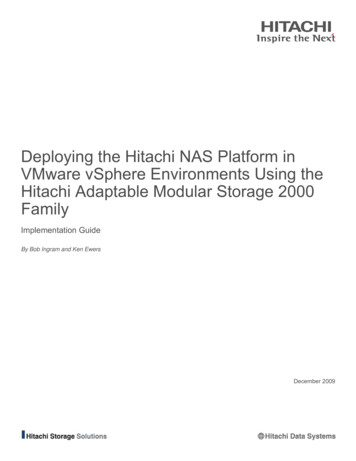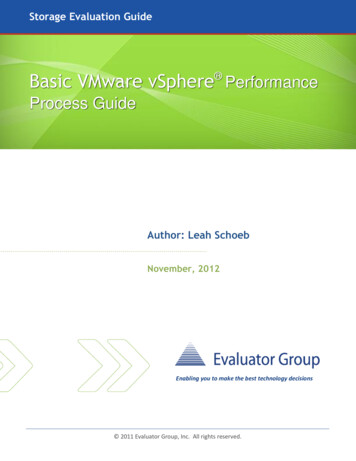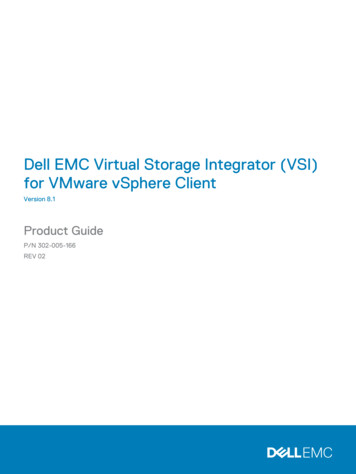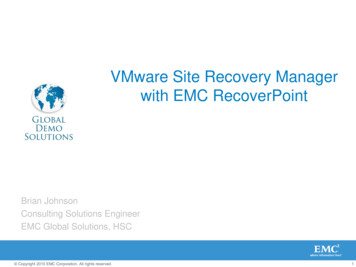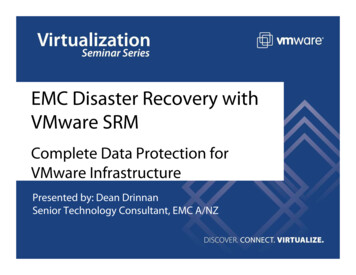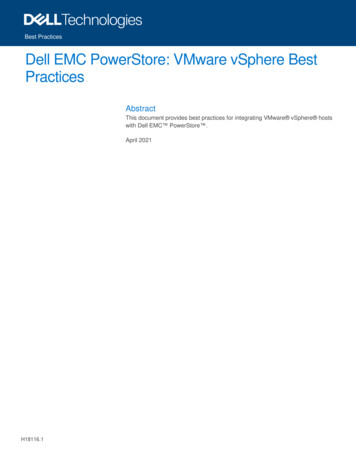
Transcription
Best PracticesDell EMC PowerStore: VMware vSphere BestPracticesAbstractThis document provides best practices for integrating VMware vSphere hostswith Dell EMC PowerStore .April 2021H18116.1
RevisionsRevisionsDateDescriptionApril 2020Initial release: PowerStoreOS 1.0April 2021Updates for PowerStoreOS 2.0AcknowledgmentsAuthor: Darin SchmitzThe information in this publication is provided “as is.” Dell Inc. makes no representations or warranties of any kind with respect to the information in thispublication, and specifically disclaims implied warranties of merchantability or fitness for a particular purpose.Use, copying, and distribution of any software described in this publication requires an applicable software license.This document may contain certain words that are not consistent with Dell's current language guidelines. Dell plans to update the document oversubsequent future releases to revise these words accordingly.This document may contain language from third party content that is not under Dell's control and is not consistent with Dell's current guidelines for Dell'sown content. When such third-party content is updated by the relevant third parties, this document will be revised accordingly.Copyright 2020-2021 Dell Inc. or its subsidiaries. All Rights Reserved. Dell Technologies, Dell, EMC, Dell EMC and other trademarks are trademarksof Dell Inc. or its subsidiaries. Other trademarks may be trademarks of their respective owners. [4/14/2021] [Best Practices] [H18116.1]2Dell EMC PowerStore: VMware vSphere Best Practices H18116.1
Table of contentsTable of contentsRevisions.2Acknowledgments .2Table of contents .3Executive summary.5Audience .512Introduction .61.1PowerStore overview .61.2VMware vSphere overview .61.3Prerequisite reading .61.4Terminology .6Host configuration .72.1Queue depth .72.2Timeouts .72.2.1 ESXi host timeouts .72.2.2 Guest operating system timeouts .72.3Multipathing .82.3.1 Native Multipathing Plug-in (NMP) .82.3.2 High Performance Plug-in (HPP).82.43Operating system disk formats .9Sizing and performance optimization .103.1Volume and VMFS datastore sizing .103.1.1 Increasing the size of VMFS datastores .113.2Performance optimizations .113.2.1 Virtual machines per VMFS datastore .113.2.2 Modifying VMFS queue depth .123.2.3 Multiple-VM and single-VM-per-volume strategies.1243.3Virtual machine affinity with Model X appliances .133.4Partition alignment .133.5Guest vSCSI adapter selection .143.6Array offload technologies .14Management and monitoring.154.1Mapping or unmapping practices .154.1.1 Cluster mappings .153Dell EMC PowerStore: VMware vSphere Best Practices H18116.1
Table of contents4.1.2 Properly unmapping volumes from ESXi hosts .165A4.2Thin clones .174.3Data encryption.174.4Space reclamation .174.5VASA .184.6Virtual Volumes.194.7Scripting and automation .194.8Dell EMC Virtual Storage Integrator .194.9vRealize Orchestrator .20Data protection and disaster recovery .215.1Snapshots and recoveries .215.2Snapshots and options for application backup and restore .215.3Crash consistent and application consistent snapshots .235.4Replication and remote recovery .24Technical support and resources .25A.14Related resources .25Dell EMC PowerStore: VMware vSphere Best Practices H18116.1
Executive summaryExecutive summaryThis document provides recommendations, tips, and other helpful guidelines for integrating external VMware vSphere hosts with the Dell EMC PowerStore platform.AudienceThis document is intended for IT administrators, storage architects, partners, and Dell Technologies employees. This audience also includes any individuals who may evaluate, acquire, manage, operate, ordesign a Dell EMC networked storage environment using PowerStore systems.5Dell EMC PowerStore: VMware vSphere Best Practices H18116.1
Introduction1IntroductionDell EMC PowerStore is a robust and flexible storage option that is ideal for use with VMware vSphere.1.1PowerStore overviewPowerStore achieves new levels of operational simplicity and agility. It uses a container-based microservicesarchitecture, advanced storage technologies, and integrated machine learning to unlock the power of yourdata. PowerStore is a versatile platform with a performance-centric design that delivers multidimensionalscale, always-on data reduction, and support for next-generation media.PowerStore brings the simplicity of public cloud to on-premises infrastructure, streamlining operations with anintegrated machine-learning engine and seamless automation. It also offers predictive analytics to easilymonitor, analyze, and troubleshoot the environment. PowerStore is highly adaptable, providing the flexibility tohost specialized workloads directly on the appliance and modernize infrastructure without disruption. It alsooffers investment protection through flexible payment solutions and data-in-place upgrades.1.2VMware vSphere overviewVMware vSphere is the industry-leading virtualization platform and a core building block to the softwaredefined data center (SDDC). VMware vSphere is primarily composed of vCenter for management andESXi hosts that provide the hypervisor for compute and memory virtualization.1.3Prerequisite readingBefore implementing the best practices in this document, it is recommended to review the Dell EMCPowerStore Host Configuration Guide and the other resources available at the PowerStore Info Hub.1.4TerminologyThe following terms are used with PowerStore:Appliance: The solution containing a base enclosure and attached expansion enclosures. The size of anappliance could include only the base enclosure or the base enclosure plus expansion enclosures.Base enclosure: The enclosure containing both nodes (node A and node B) and the NVMe drive slots.Cluster: Multiple PowerStore appliances in a single grouping.Expansion enclosure: Enclosures that can be attached to a base enclosure to provide additional SAS-baseddrive slots.Node: The component within the base enclosure that contains processors and memory. Each applianceconsists of two nodes.PowerStore Manager: The web-based user interface (UI) for storage management.NVMe over Fibre Channel (NVMe-FC): Allows hosts to access storage systems across a network fabric withthe NVMe protocol using Fibre Channel as the underlying transport.6Dell EMC PowerStore: VMware vSphere Best Practices H18116.1
Host configuration2Host configurationWhile most settings for stand-alone ESXi hosts that are connected to PowerStore appliances can remain atthe default values, some changes are required for PowerStore stability, performance, and efficiency. Therecommended changes and instructions about how to set them are specified in the document Dell EMCPowerStore Host Configuration Guide on the PowerStore Info Hub. While administrators can use this sectionfor high-level explanations and reasoning behind the recommendations, administrators should see the HostConfiguration Guide for the current settings.Caution: These recommended settings are for external ESXi hosts only, and do not apply to the ESXiinstances running within PowerStore X model appliances.Note: Dell EMC Virtual Storage Integrator (VSI) allows administrators to easily configure the ESXi host bestpractice settings with PowerStore. See section 4.8 for more details.2.1Queue depthThere are multiple locations within ESXi and the guest operating systems to modify queue depth. Whileincreasing the queue depth in an application, vSCSI device, or ESXi driver module can potentially increaseperformance, modifying or increasing queue depths can potentially overwhelm the array. For details aboutqueue-depth settings, see the document Dell EMC PowerStore Host Configuration Guide.2.2TimeoutsSetting disk timeouts is an important factor for applications to survive both unexpected and expected nodeoutages, such as failures or rebooting for updates. While the default SCSI timeout in most applications andoperating systems is 30 seconds, storage and application vendors typically recommend increasing thesetimeouts to 60 seconds or more to help ensure uptime. Two of the main locations to change the timeouts areat the ESXi host level and at the virtual-machine-guest-OS level. For details on setting timeouts for ESXi, seethe Dell EMC PowerStore Host Configuration Guide.2.2.1ESXi host timeoutsThe timeout values set at the ESXi-host-driver level help ensure that the hosts and virtual machines cansurvive a storage node failover event. For details on setting timeouts for ESXi, see the Dell EMC PowerStoreHost Configuration Guide.2.2.2Guest operating system timeoutsIf VMware Tools is installed into a guest operating system, it automatically sets the timeout values. However,if the guest operating system does not have VMware Tools installed, the administrator can set these valuesmanually. While VMware documentation has examples on setting the disk timeouts in Microsoft Windows guest operating systems, consult the knowledge bases from operating system vendors to obtain specificguest settings.7Dell EMC PowerStore: VMware vSphere Best Practices H18116.1
Host configuration2.3MultipathingWith the vSphere Pluggable Storage Architecture (PSA), the storage protocol will determine whichMultipathing Plugin (MPP) is assigned to volumes mapped from the PowerStore array. With SCSI-basedprotocols such as Fibre Channel and iSCSI, the Native Multipathing Plug-in (NMP) is used, whereas withNVMe-oF, the VMware High Performance Plug-in (HPP) will be used.2.3.1Native Multipathing Plug-in (NMP)While SCSI-based volumes using Fibre Channel and iSCSI are automatically assigned the NMP, the ESXiStorage Array Type Plug-in (SATP) module and its corresponding path selection policy (PSP) may need claimrules to be configured to use Round Robin (RR) with PowerStore appliances. Applying the settings in the DellEMC PowerStore Host Configuration Guide ensures that all volumes presented to the host use Round Robinas the default pathing policy.Also, the recommended esxcli command sets the IOPS path-change condition to one I/O per path. While thedefault setting within the RR PSP sends 1,000 IOPS down each path before switching to the next path, thisrecommended setting instructs ESXi to send one command down each path. This results in better utilizationof each path’s bandwidth, which is useful for applications that send large I/O block sizes to the array.2.3.2High Performance Plug-in (HPP)For NVMe-oF targets, the HPP replaces the NMP. The HPP will claim NVMe devices and is designed toimprove storage performance for modern high-speed interfaces.In addition, the HPP has multiple Path Selection Schemes (PSS) available to determine which physical pathsare used for I/O requests. By default, the HPP uses the Load Balance – Round Robin (LB-RR) Path SelectionScheme recommended by the Dell EMC PowerStore Host Configuration Guide, so no additional changes orclaim rules are required.For more information about NVMe-oF and the High Performance Plug-in, see the following resources on theVMware website: 8VMware NVMe ConceptsVMware High Performance Plug-In and Path Selection SchemesRequirements and Limitations of VMware NVMe StorageDell EMC PowerStore: VMware vSphere Best Practices H18116.1
Host configuration2.4Operating system disk formatsWhile most versions of VMFS are backwards-compatible, it is a best practice to verify and use the latestversion of VMFS recommended by VMware. Typically, new VMFS versions are bundled with an ESXiupgrade. As a migration path, VMware vCenter allows administrators to use VMware vSphere StoragevMotion to migrate virtual machines to new VMFS datastores formatted with the latest version.Example of datastore properties showing the VMFS versionNote: PowerStore X model appliances use VMware vSphere Virtual Volumes (vVols) storage containers forstorage of virtual machines that run on internal PowerStore X model nodes. While it is not best practice, blockvolumes can only be presented to the internal ESXi hosts within PowerStore X model using the REST API.9Dell EMC PowerStore: VMware vSphere Best Practices H18116.1
Sizing and performance optimization3Sizing and performance optimizationThere are several best practices for provisioning storage from a PowerStore appliance to an external vSpherecluster. The size of VMFS datastores and the number of virtual machines that are placed on each can affectthe overall performance of the volume and array.Virtual machines running within PowerStore X model internal nodes use internal vVol storage by default.However, since the PowerStore X model can simultaneously run VMs on internal nodes and serve storage toexternal ESXi hosts, the VMFS datastore sizing and virtual-machine placement strategies that are detailed inthis section are only applicable when using PowerStore as storage to external ESXi hosts.3.1Volume and VMFS datastore sizingWhen a volume is created on PowerStore T models, the best practice is to create a volume no larger thanneeded and use a single VMFS partition on that volume.While the maximum datastore size can be up to 64 TB, it is recommended to begin with a small datastorecapacity and increase it as needed. Right-sizing datastores prevents accidentally placing too many virtualmachines on the datastore, thus decreasing the probability of resource contention. Since datastore andVMDK sizes can be easily increased if a virtual machine needs additional capacity, it is not necessary tocreate datastores larger than required. For optimal performance, best practice is to increase the number ofdatastores rather than increase th
Note: Dell EMC Virtual Storage Integrator (VSI) allows administrators to easily configure the ESXi host best-practice settings with PowerStore. See section 4.8 for more details. 2.1 Queue depth There are multiple locations within ESXi and the guest operating systems to modify queue depth. While
